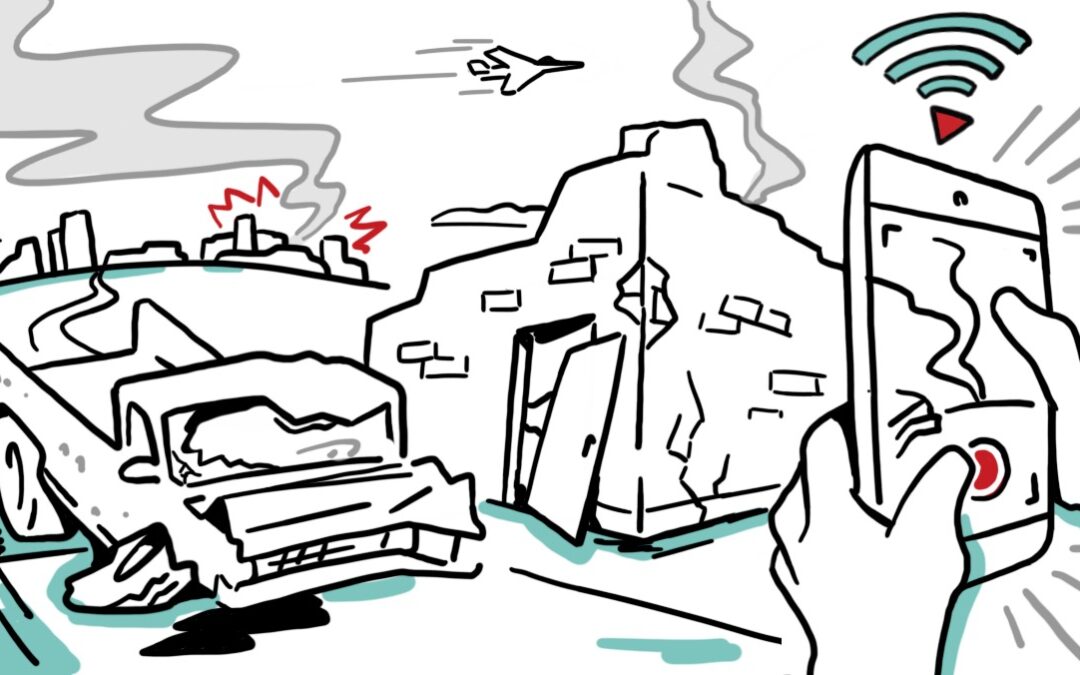Wars don’t do well in photographs. It’s hard to add nationalism or glory to a burned-out building, and a pickup truck shelled into oblivion doesn’t send an uplifting message. This is part of the reason why the Vietnam War ended when it did: TV cameras kept the horror fresh in eyes around the world, and there was little to no way to make the fighting sound just, worthwhile, or good.
With the amount of visuals coming from Ukraine, let’s all hope against hope that the conflict is similarly brought to a swift end. This time, social media is carrying a lot of the weight—especially TikTok. As former US Army journalist Daniel Johnson told ABC, “In previous wars, we’d have people help with giving supplies or letters. Now you have a video post.”
Trends and Trenches: TikTok at War
“Call it the birth of WarTok,” writes Matteo Mobilio of the platform’s usage during the invasion. WarTok is pretty much exactly what it sounds like: civilians, soldiers, and Ukrainians of all ages and backgrounds (Mobilio notes that “it’s a one-sided view; we’re not seeing TikToks from Russian forces”) are using TikTok to reflect the madness around them.
“The videos are often short and fly by too quickly for any meaningful context… a cacophony of explosions, machine-gun fire, and dancing soldiers, each clip seemingly more absurd or disturbing than the last,” Mobilio describes standard WarTok fare.
This is an interesting revision of a common criticism of TikTok (in a peacetime context): it’s too short, too weird, and too zeroed in on the present moment.
These characteristics might make normal TikToks strange to the uninitiated, but they are perfect for the aims of WarTok. War is absurd, and it is disturbing. It is senseless, cruel, and it replaces the lives of those caught in the middle with a survivalist desperation.
WarTok makes sense for so many reasons, it’s daunting to name them all. It’s easy to shoot, it’s borderline cost-free, it’s easy to disseminate, and it’s thematically aligned with its subject matter. The lack of “meaningful context” Mobilio describes is the meaningful context. Ukraine did nothing and rockets came through its windows; none of the dead had time to create a “context.”
WarTok might be a purely Ukrainian expression of rage, angst, and anxiety, but Russian TikTok and Instagram influencers are also using visual storytelling to speak out against the violence.
Russian Influencers Tell a Similar Story
“I don’t have any political knowledge nor opinion, but all I can say is: I am always against war and for the people,” Chris Stokel-Walker quotes Russian influencer Xenia Tchoumitcheva for The Guardian.
Tchoumitcheva was one of many Russian influencers who so far have chosen visual representations of their condemnation of the onslaught. Many have opted for a black square on their Instagram, an extremely simple but fully unambiguous symbol of rejection and refusal to take part. Others have used Ukrainian flags (waved, and face-painted, sometimes in concert with Russian flags) and others still have posted their geographically-removed version of WarTok. Their videos, like those Stokel-Walker references from Ilya Varlamov, “[highlight] Russian brutality, calling for a cessation of violence in Ukraine.”
The visual storytelling from both Ukrainian and from Russian influencers, via WarTok, Instagram, or other platforms is crystal clear: this is wrong, and only by showing it to the world will we have a chance of stopping it. These videos are powerful—but they’re not the complete story.
Preparing for the Worst
Reuters’ photographers captured an arresting series of images in Zhytomyr, Ukraine: civilians training to defend their homes with Molotov cocktails. The still images tell a story that’s somewhat reassuring, but more accurately heartbreaking and horrifying.
Over the course of 19 photos, these normal people (one of whom looks to be in his mid-teens) can be seen creating, lighting, and throwing the improvised incendiary devices in a practice setting. The ‘reassuring’ part comes from working together, but the nature of that work—the necessity of training non-violent people how to throw firebombs—is depressing.
The story here is obvious, and the message crystal clear: this is not what solidarity should look like. Or, if you like: if only this many people were working together for something positive.
There are moments, though, that tell a very different visual story than the influencers who post on TikTok (or WarTok, as the case may be) and the journalists who captured Zhytomyr’s preparations wanted to tell.
Life Goes On
Just as war goes ignored by much of the world, wherever it breaks out, it can somehow recede into the background of the minds of those fighting it. Take this photo of a Ukrainian girl catching a snowflake on her tongue. The caption tells us that she was waiting to board a train to Poland, and amongst everything, she looks happy. In this moment, at least, life goes on.
That’s the power of modern visual storytelling: to communicate, in real-time, the on-the-ground truth of a major event like this one, across the world and around language barriers. Equal parts scary, heartbreaking, bizarre, and even reassuring, it’s this kind of coverage that lets the world see such violence for what it is: an unconscionable mess.

